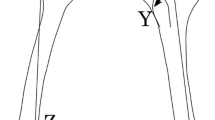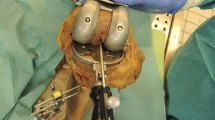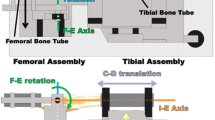Abstract
Purpose
Complications after total knee arthroplasty (TKA) often involve the patellofemoral joint, and problems with patellar maltracking or lateral instability have sometimes been addressed by external rotation of the femoral component. This work sought to measure the changes of knee kinematics caused by TKA and then to optimise the restoration of both the patellofemoral and tibiofemoral joint kinematics, by variation of femoral component internal–external rotation.
Methods
The kinematics of the patella and tibia were measured in eight cadaveric knees during active extension motion. This was repeated with the knee intact, with a Genesis II TKA in the standard position (3° of external rotation) and with the femoral component at ±5° rotation from there.
Results
Both patellar and tibial motions were significantly different from normal with the standard TKA rotation, with 3° tibial abduction at 90° flexion and reversal of the screw-home from 5° external rotation to 6° internal rotation. The patella was shifted medially 6 mm in flexion and tilted 7° more laterally near extension. Femoral rotation to address one abnormality caused increased abnormality in other degrees of freedom. Internal and then external rotation of 5° caused tibial abduction and then adduction of 5° at 90° flexion. These femoral rotations also caused increased patellar lateral tilt of 4° with femoral external rotation and decreased tilt by 4° with internal rotation. Thus, correction of tibial abduction in flexion, by external rotation of the femoral component, worsened the patellar lateral tilt near extension.
Conclusions
It was concluded that femoral rotation alone could not restore all aspects of both patellar and tibial kinematics to normal with this specific implant. The clinical relevance of this is that it appears to be inadvisable to reposition the femoral component, in an attempt to improve patellar tracking, if that repositioning may then cause abnormal tibiofemoral kinematics. Further, the pattern of patellar tracking, with the type of TKA used in this study, could not be adjusted to normal by femoral component rotation.








Similar content being viewed by others
References
Akagi M, Matsusue Y, Mata T, Asada Y, Horiguchi M, Iida H, Nakamura T (1999) Effect of rotational alignment on patellar tracking in total knee arthroplasty. Clin Orthop Relat Res 366:155–163
Banks SA, Harman MK, Bellemans J, Hodge WA (2003) Making sense of knee kinematics: news you can use. J Bone Jt Surg (Am) 85:64–72
Berger RA, Crossett LS, Jacobs JJ, Rubash HE (1998) Malrotation causing patellofemoral complications after total knee arthroplasty. Clin Orthop Relat Res 356:144–153
Bose K, Kanagasuntheram R, Osman MBH (1980) Vastus medialis oblique—an anatomic and physiologic study. Orthopedics 3:880–883
Bull AM, Andersen HN, Basso O, Targett J, Amis AA (1999) Incidence and mechanism of the pivot shift. An in vitro study. Clin Orthop Relat Res 363:219–231
Chew JTH, Stewart NJ, Hanssen AD, Luo ZP, Rand JA, An KN (1997) Differences in patellar tracking and knee kinematics among three different total knee designs. Clin Orthop Relat Res 345:87–98
Dalury DF, Dennis DA (2003) Extensor mechanism problems following total knee replacement. J Knee Surg 16:118–122
Farahmand F, Senavongse W, Amis A (1998) Quantitative study of the quadriceps muscles and trochlear groove geometry related to instability of the patellofemoral joint. J Orthop Res 16:136–143
Farahmand F, Tahmasbi MN, Amis AA (1998) Lateral force-displacement behaviour of the human patella and its variation with knee flexion–a biomechanical study in vitro. J Biomech 31:1147–1152
Feinstein WK, Noble PC, Kamaric E, Tullos HS (1996) Anatomic alignment of the patellar groove. Clin Orthop Relat Res 331:64–73
Grood ES, Suntay WJ (1983) A joint coordinate system for the clinical description of three-dimensional motions: application to the knee. J Biomech Eng 105:136–144
Heegaard JH, Leyvraz PF, Hovey CB (2001) A computer model to simulate patellar biomechanics following total knee replacement: the effects of femoral component alignment. Clin Biomech 16:415–423
Iranpour F, Merican AM, Baena FR, Cobb JP, Amis AA (2010) Patellofemoral joint kinematics: the circular path of the patella around the trochlear axis. J Orthop Res 28:589–594
Jerosch J, Peuker E, Philipps B, Filler T (2002) Inter-individual reproducibility in perioperative rotational alignment of femoral components in knee prosthetic surgery using the transepicondylar axis. Knee Surg Sports Traumatol Arthrosc 10:194–197
Kaper BP, Woolfrey M, Bourne RB (2000) The effect of built-in external femoral rotation on patellofemoral tracking in the Genesis II total knee arthroplasty. J Arthroplast 15:964–969
Kelly MA (2001) Patellofemoral complications following total knee arthroplasty. Instr Course Lect 50:403–407
Kessler O, Colwell CW, D’Lima DD (2008) The effect of femoral component rotation on patellar biomechanics. J Biomech 41:3332–3339
Kwak SD, Ahmad CS, Gardner TR, Grelsamer RP, Henry JH, Blankevoort L, Ateshian G, Mow VC (2000) Hamstrings and iliotibial band forces affect knee kinematics and contact pattern. J Orthop Res 18:101–108
Lie DT, Bull AM, Amis AA (2007) Persistence of the mini pivot shift after anatomically placed anterior cruciate ligament reconstruction. Clin Orthop Relat Res 457:203–209
Malo M, Vince KG (2003) The unstable patella after total knee arthroplasty: etiology, prevention, and management. J Am Acad Orthop Surg 11:364–371
Merican AM, Amis AA (2009) Iliotibial band tension affects patellofemoral and tibiofemoral kinematics. J Biomech 42:1539–1546
Merican AM, Ghosh KM, Deehan DJ, Amis AA (2009) The transpatellar approach for the knee in the laboratory. J Orthop Res 27:330–334
Miller MC, Berger RA, Petrella AJ, Karmas A, Rubash HE (2001) The Ranawat award paper—optimizing femoral component rotation in total knee arthroplasty. Clin Orthop Relat Res 392:38–45
Nagamine R, Whiteside LA, Otani T, White SE, McCarthy DS (1996) Effect of medial displacement of the tibial tubercle on patellar position after rotational malposition of the femoral component in total knee arthroplasty. J Arthroplast 11:104–110
Powers CM, Lilley JC, Lee TQ (1998) The effects of axial and multi-plane loading of the extensor mechanism on the patellofemoral joint. Clin Biomech 13:616–624
Rhoads DD, Noble PC, Reuben JD, Mahoney OM, Tullos HS (1993) The effect of femoral component position on patellar tracking after total knee arthroplasty. Clin Orthop Relat Res 260:43–51
Sodha S, Kim J, McGuire KJ, Lonner JH, Lotke PA (2004) Lateral retinacular release as a function of femoral component rotation in total knee arthroplasty. J Arthroplast 19:459–463
VanKampen A, Huiskes R (1990) The 3-dimensional tracking pattern of the human patella. J Orthop Res 8:372–382
Wiles AD, Thompson DG, Frantz DD (2004) Accuracy assessment and interpretation for optical tracking systems. Med Imaging, Proc. 5367, visualization, image-guided procedures, p 12
Worland RL, Jessup DE, Johnson GVV, Alemparte JA, Tanaka S, Rex FS, Keenan J (2002) The effect of femoral component rotation and asymmetry in total knee replacements. Orthopedics 25:1045–1048
Acknowledgments
K. Milton Ghosh and the running costs of this work were supported by Smith and Nephew (Reconstructive) Ltd., UK. Azhar M Merican was supported by the University of Malaya Medical Centre, Kuala Lumpur and the Arthritis Research (UK) charity. Farhad Iranpour was supported by the Furlong Charitable Research Foundation. We thank W. Scott Selbie PhD, C-Motion Inc., for his software support. None of the authors have any financial or commercial links that may be perceived to have biased this article.
Author information
Authors and Affiliations
Corresponding author
Rights and permissions
About this article
Cite this article
Merican, A.M., Ghosh, K.M., Iranpour, F. et al. The effect of femoral component rotation on the kinematics of the tibiofemoral and patellofemoral joints after total knee arthroplasty. Knee Surg Sports Traumatol Arthrosc 19, 1479–1487 (2011). https://doi.org/10.1007/s00167-011-1499-8
Received:
Accepted:
Published:
Issue Date:
DOI: https://doi.org/10.1007/s00167-011-1499-8




